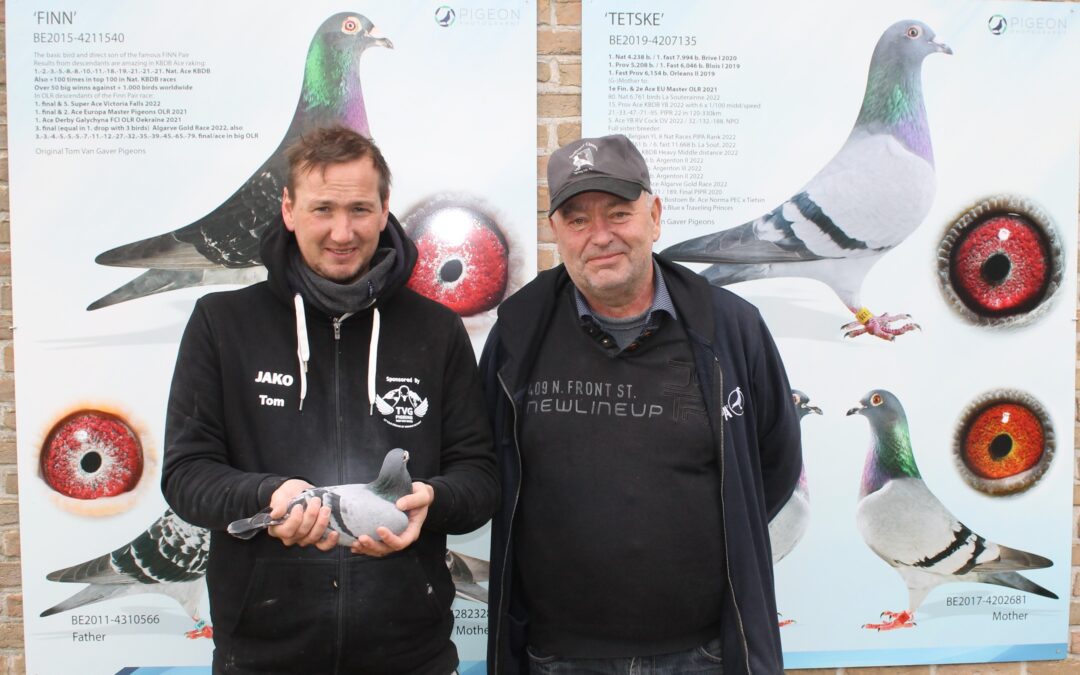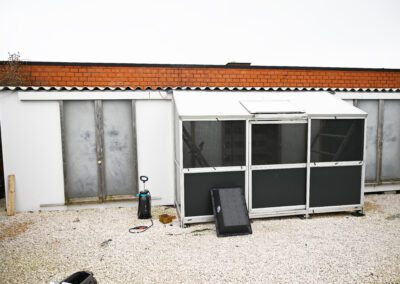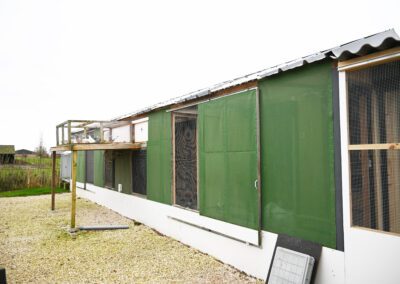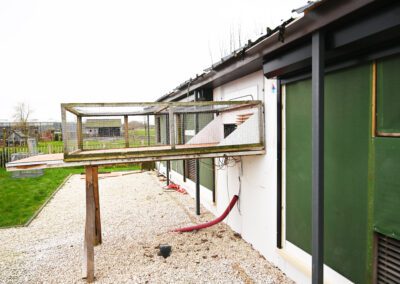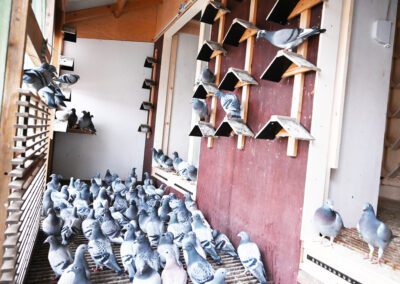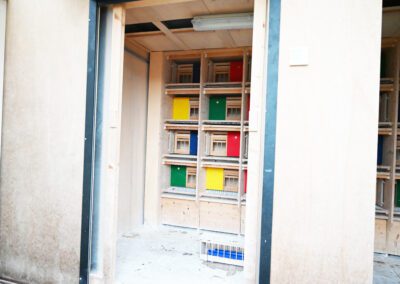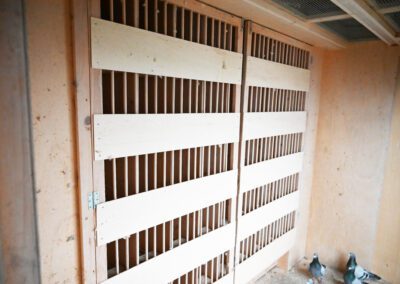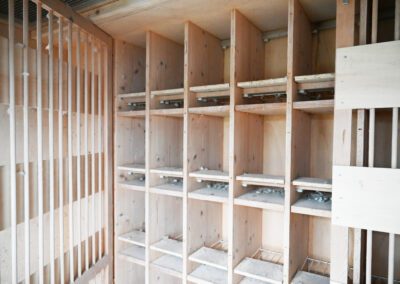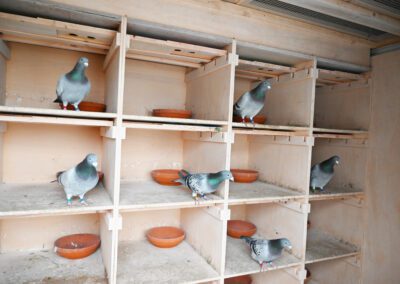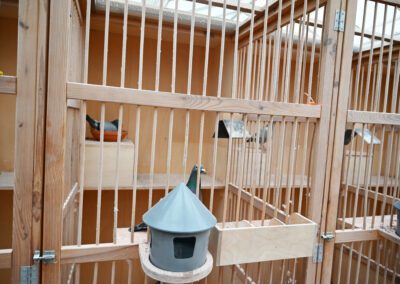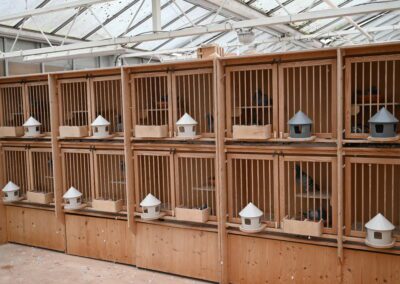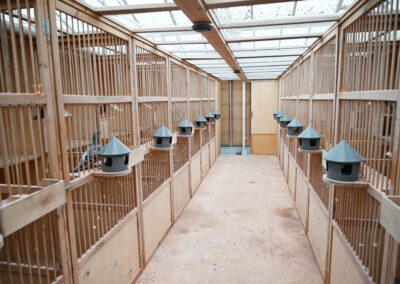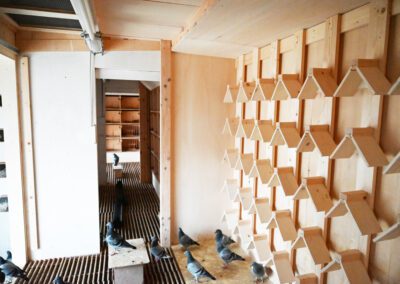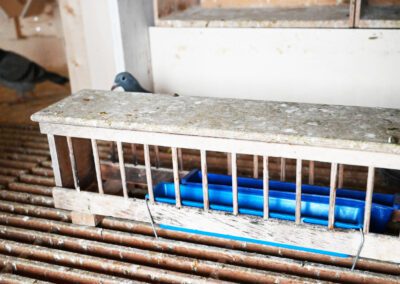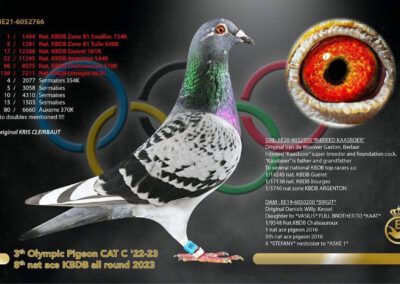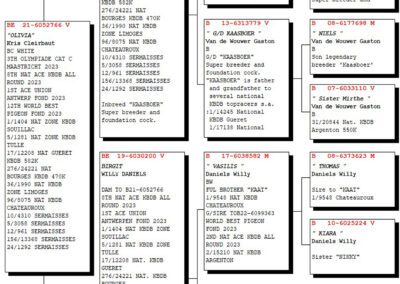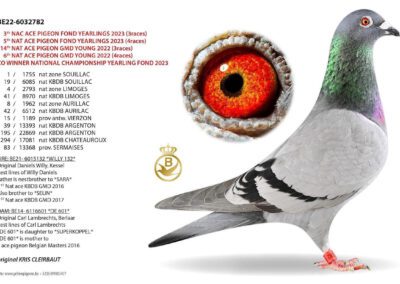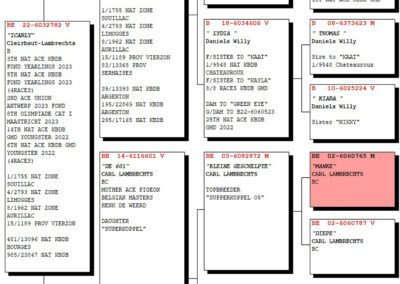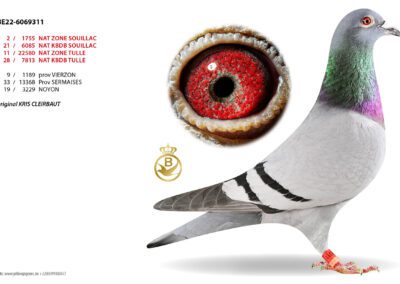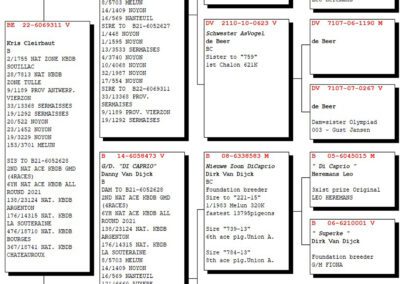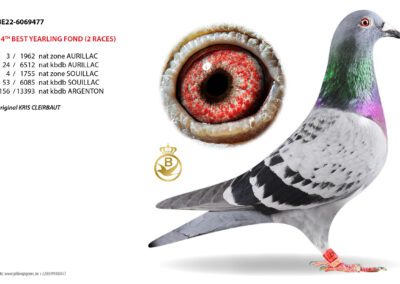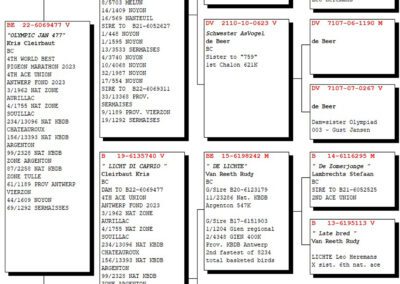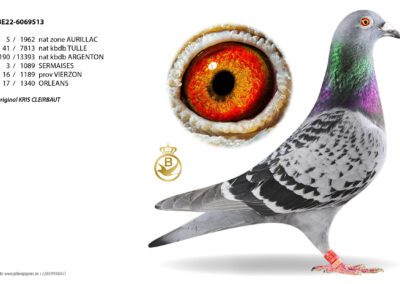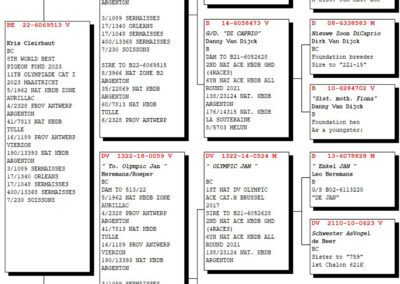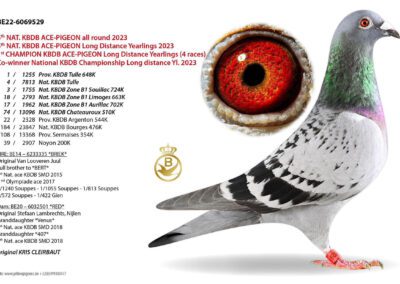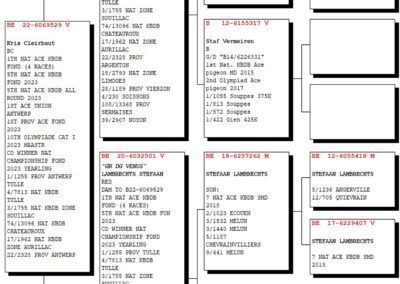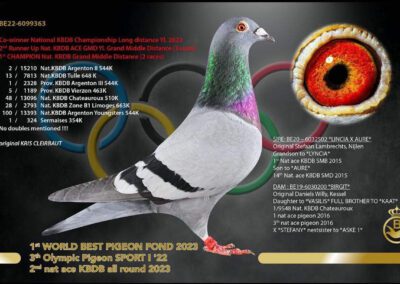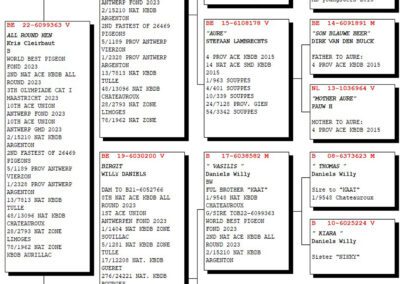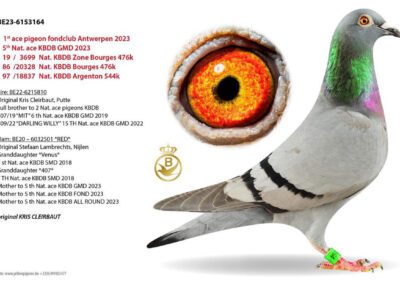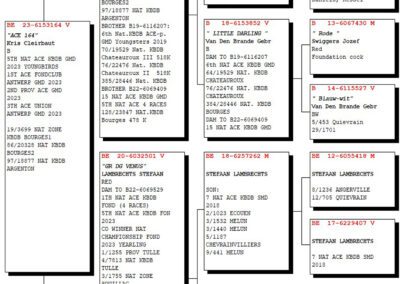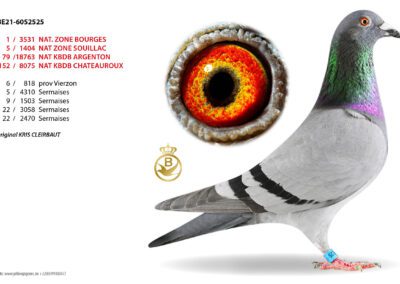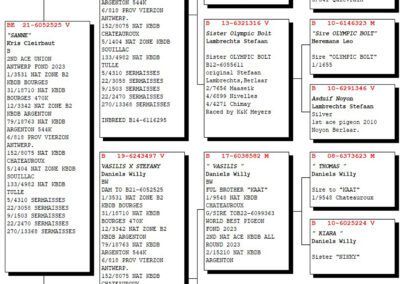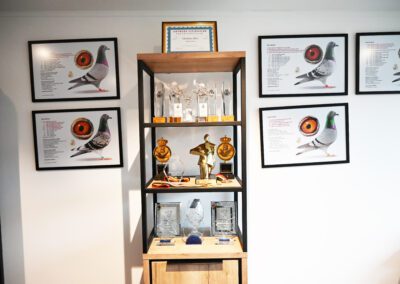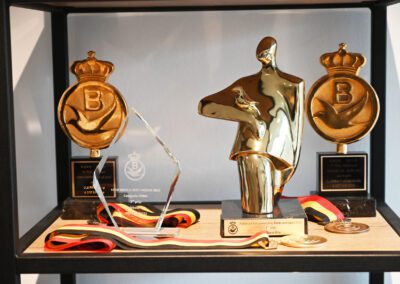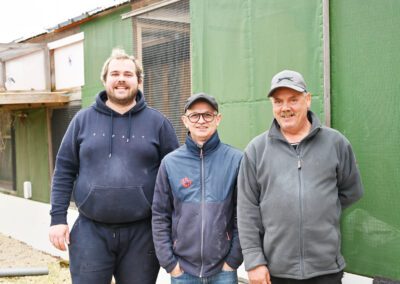Golden frame 2023
NL20-1525613 – 1st National Ace Small middle distance Old KBDB 2023
BE21-4201779 – 3rd National Ace All-round Old & Yearlings KBDB 2023
BE21-4201816 – 4th National Ace All-round Old & Yearlings KBDB 2023
BE21-4201705 – 7th National Ace All-round Old & Yearlings KBDB 2023
BE21-4201732 – 9th National Ace All-round Old & Yearlings KBDB 2023
BE21-4201732 – 1st National Ace Fond Old KBDB 2023
BE21-4201779 – 5th National Ace Old KBDB 2023
BE21-4201952 – 11th National Ace Old KBDB 2023
BE21-4201811 – 21st National Ace Old KBDB 2023
BE22-4055088 – 4th National Ace yearbirds KBDB 2023
BE19-4207283 – 9th National Ace Great Middle Distance Old KBDB 2023
BE21-4201784 – 25th National Ace All-round Old & Yearlings KBDB 2023
7th National Champion Fond Old KDBD 2023
13th National Champion Fond yearbirds KBDB 2023
21st National general champion KBDB 2023
57 x top 100 national
1st & 2nd Olympiad bird Maastricht ’24 (Cat. C)
1st Olympiad bird Maastricht ’24 (Cat. H)
Back in time….
We briefly put a few teeth (read years) back in our tele time machine and flash back to the Tuesday after the weekend of 14 June 2014. Yours truly is visiting young hunk Tom Van Gaver in Moortsele. Tom was well known to us as the son of Marnik Van Gaver and for us Marnik was always a formidable competitor in the long-distance and heavy-distance with regularly a number of pigeons in the head of the race (and provincial and national top rankings on top).
Tom was 27 at the time, some moss still hung behind his ears and he did it with a few kilograms less than now (37 years old). But what he still had too much in “green”, he had in guts in surplus.
He had once shown his teeth and talents the weekend before on a rock-hard national Poitiers and a rock-hard national Cahors.
Poitiers (club 370 old birds) : 1,6,9,14,17,24,25,30,35,39,89,95,102,108 (14/14). First bird makes a velocity of 1,076 m per minute
Poitiers (club 630 yearbirds) : 1,4,5,6,14,16,18,20,23,29,37,44,57…..(28/29). First bird makes a velocity of 1,066 m per minute.
Cahors (club 162 duiven) : 1,4,6,12,14,34 (6/8). First bird makes a velocity of 1,029 meter per minute.
Provincially and nationally the first pigeons also flew top, but it was mainly the series that was put down that had impressed me. It was not the first time Tom had done so hard, but now just about everyone noticed. When we got hold of the pigeons that “did it” on Tuesday, they were ready to basket again. There was no sense in anything that they had finished such a tough flight. Then I was convinced that here
- a) Top quality pigeons were present and
- b) We were dealing with a talented caretaker who was gradually making his mark on modern pigeon racing.
In my neighborhood between the famous pots and pints at a basketing, I used to say that if we were patient for a few more years, we would have a real super champion in the ring.
Why this assertion ? When we put the pigeons in our hands, there was not one inferior pigeon, they were all very strong and had everything we can expect from a top athlete. In addition, they were played and sorted with a boldness and guts that this approach could also create a new trend in traditional pigeon racing.
A non-negotiable part of this growth process was also undoubtedly the role of shadow mentor that his father Marnik fulfilled and still fulfils. Marnik himself no longer had anything to prove in pigeon racing and sometimes watched with wide eyes as his son Tom ran rampant. Still, he managed to occasionally brake where it was really needed and add a little filing here and there to Tom’s sculpture. And this until he established…to his great satisfaction, that in this case, youth did and does know better.
Reculer pour mieux sauter
A saying we could already use a few times is certainly applicable here too in Tom’s case. Taking a (forced) big step back only to jump even further than initially foreseen with full élan.
A more than fruitful cooperation had developed under the name DVV-pigeons. Top results were achieved on the three lofts where the disciplines were played. The machine had enough grease between the cogs in the form of a strong colony of pigeons based on a very strong base in the breeding loft. We sometimes call it a king pair but here the basic pair was called the Dream Pair. A Dream Pair ? What’s in a name ? It was a 2003 hen, which itself performed very well in long distance races (and still had the old Catrysse and Nouwen-Paesen origins) that suddenly felt the need to cheat on its neighbors. And those neighbours were Johan De Vroe’s pigeons. As the fire could not be put out, she was quartered with Johan and paired with a top pigeon with him christened as Kleine Schoonen (from the noble bloodlines Gaby Vandenabeele and René Vandenheede, father of Jacques and Freddy).
Voilà, so simple is the recipe of a dream couple or an example of how nature does not always let itself be chastened the way man wants it…and thankfully so.
It would be all too cliché to generalize but just about everything this pair put on the world flew top or could be switched on to inherit like the best. Even now, the entire lineage of these pigeons is laced with this blood. It is also a line that can be crossed very well with other pigeons and eventually has led to the current results that make everyone dizzy.
Where people work together there is “mingling” and also in the cooperation under the name DVV-pigeons became cracks. This resulted in a total sale of pigeons in 2017. And for Tom, it was a deep sigh and then a gasp. A top breeding loft and top flight lofts were dismantled, it was hard to watch this long-standing weave unravel.
There was counting and counting and full of ambition but also with pinched buttocks Finn was bought back at auction and at a later stage Ricky. But can you make a new spring with one or two swallows ? With the help of some good friends like Sam Bostoen and brother-in-law Davy Neyrinck, some youngsters from the better racers were kept and some of the noble blood of that super pigeon strain was within reach. We also bred together with Bart Geerinckx and exchanged with him.
Surely it was anxious to see whether these youngsters had enough good blood in them to write a new chapter again, under the wings of Tom and his top pigeon Finn. But what seemed like a crisis operation turned out to be a golden move. The breeding loft very quickly showed its surplus of quality with very encouraging results that raised hopes for the coming years…and so it happened.
Very strong performances were achieved again soon after, it took some trial and error to get the last screws in the breeding and the game in the right place, but what is good usually comes fast…and the results of the last few seasons have gone crescendo with season 2023 as the absolute highlight.
With these results, Tom and Marnik join the ranks of the all-time greats.
The question on everyone’s lips….How do you do it?
With only one question in the back of our minds, we drove to Moortsele, namely the question on everyone’s lips who followed last year’s performances: how do you do it ?
For some years now, in many conversations there is a subject that always comes up, namely “how does Tom do it to play his pigeons at that level every week” ?
And it is striking that this trend is not only with Tom. Several lofts are doing this or testing it out. Each week in the basket, 3 weeks in a row in the basket and then a week of rest, as an intermediate race a speed race, as an intermediate race the heavy middle-distance,…. and a whole menu of new ways of racing have meanwhile appeared and with success !
Tom is very clear in this, namely that this is a playing style he has used and tested for years. You have to give them when they are in condition and then play, top grooming, and those who can handle the regime will come and those who can’t will be selected out.
While saying this, the expression “daddy got stuck in the sixties” haunts me”….. Within pigeon racing, and as in many customs, people tend to stick hard to what is known and familiar to them, something that works and carries little risk, but usually history is made by the innovators.
It is then up to the innovators, the daredevils, people with a broader vision to test out other things. By trial and error, by success and failure…. Everyone laughed at Elon Musk a few years back when he designed an electric car and said he would launch a rocket into space….We are now 10 years on and these cars are conquering the market and the rocket has already been launched.
And yes, it costs feathers, but pigeon racing has evolved in previous years. The program is heavier, more intense, the shelf life of pigeons is shorter, more is expected of our feathered friends than in the past…..but Pogacar was only 19 years old when he already shone at the highest level, the same for Evenepoel, tennis players of 18 years old also play finals of big tournaments…..and then my late mother would have said “they get a better living than before”…
“The court of the trot, whoever can’t keep up goes off”…
This is heard repeatedly in my youth when it was indicated that work had to be done. Tom applies this principle…but, but, but, but anything but recklessly. That sharp edge has been filed off in recent years.
The pigeons are played on the edge but only after thorough observation and evaluation and in good condition.
During the season, Marnik and Tom do everything to bring and keep the pigeons in top condition. When this condition is present they are played hard and intensely, but certainly not recklessly and thoughtlessly played to pieces.
We noticed that during the interview, they play hard but correctly and with an iron hand wrapped in a velvet glove.
Some facts and to do’s for those interested
The pigeons (breeders and racers) breed before the season (pairing around Christmas – breeders 20 pairs) – Tom still has a full-time job and everything must be doable and combinable. In autumn (end of moulting), all pigeons are treated with a broad-spectrum product for a few days in order to be inoculated with (dead) paratyphoid vaccine. Two weeks later, each pigeon will be vaccinated with paramyxo-rota vaccine.
The pigeons are given 8 days of antibiotics for an entire year (…and not a day more…. unless there is a sudden outbreak of disease, which has never been the case in recent years). This antibiotic treatment is in the autumn prior to the vaccination.
- The racers then separate in mid-February and are vaccinated against paramyxo and smallpox.
- In mid-March, the racers are vaccinated with a (live) paratyphoid vaccine and this dares some to go through a dip, but the reaction afterwards has shown that it improves fitness.
- The breeding pigeons do not breed in boxes but in an open loft (with aviaries).
- All (now nicely renovated) lofts have aviaries in the front (wind-breaking netting) and these are used optimally for the pigeons to stay in (because of less cleaning work in the lofts, more in the open air and plenty of oxygen, the widower cocks sit on shelves during the day and dixit Tom this is an additional territorial motivation…).
- The racers train (in normal weather) twice a day (they are not expected to train for an hour, preferably twice for half an hour but with speed and panache). The hens train once a day and usually do train longer by themselves. The intensity of training is an initial gauge of fitness.
The pigeons are not really darkened in a truly schematic approach before the season, but the lofts are rather lightless, unlike the aviaries which do allow more light. This is “played with” in preparation for the season. However, Tom wants his pigeons from the first flight to compete for the top and therefore does not slow down so much for the national flights.
After training in the evening, the cocks are allowed to spend the night in the loft.
There is no pulling of battens before the season. Tom has certain trepidation about it and is not convinced of its usefulness. By playing with light and light shade, the intense rhythm of the races that follow each other, he has few problems with pigeons he cannot basket for the last races because of the state of their feathers or an incipient moult.
He does have supplementary lighting from early July (5.45am and 10.45am).
Tom yearns every season for the shedding of the first hen. From experience, he knows that this certainly benefits the form.
How are the pigeons observed in terms of the intense flight rhythm ?
- The first observation is the intensity of training (“there must be a cut”)
- When returning from a race (the pigeons are played in total widowhood with slightly more hens than cocks) the pigeons only stay together for a very limited time (recovery prevails).
- A first observation about the condition is made on arrival and the behavior shortly after returning home. Those that have gone very deep show this quickly.
- Regarding condition observation, the day after returning home is crucial. A pigeon in condition is alert and sharp again, one that has been deep is more passive.
- The pigeons are bathed on Monday and those that do not take a bath have usually not recovered well or sufficiently (and there is a greater chance that this pigeon will not be basketed). Ditto on Wednesday when the pigeons are bathed again, pigeons that like to bathe have condition, loiterers should be watched and possibly spared.
- D-day is on Wednesday. All pigeons are released on Wednesday morning in Ath by father Marnik. When basketing on Wednesday morning, each pigeon gets a yellow drop in each nostril. When they arrive home, Tom waits for them and has learned through experience that those that are already there by then are also his first on Saturday. Pigeons that do not arrive there are usually not very sharp. On arrival, they then get to hang out together and make love for a while. They are then also allowed to bathe and are fed plenty.
- It is abundantly clear from the foregoing that keen observation does take place to avoid pigeons willingly cracking the hard rhythm. This is not to say that no pigeons are lost, but this approach limits the damage relatively.
- Pigeons need to fly says Tom. In normal health and weather conditions, rest is not the best advisor. A weekly middle-distance flight between races is the most normal thing in the world because it keeps them in the swing of things.
- The hens and cocks are fed with Aidi Girl Power and mix 3, Beyers (Sport light,energymix, Detox Gritmix) and Vanrobaeys (relax and gritmix) and Matador mixtures (detox) whereby also preferably the detox mixtures are used when the intense schedule of the flights allows it. Peanuts and fine feed are fed to the cocks (less to the hens). Every three weeks the pigeons are given a Rozitol drop in the nose.
In the morning, supplements are never provided over the feed, when the pigeons must eat as much as possible. However, supplements are provided in the evening over the (first) feed and drink.
o These supplements include the Röhnfried range,(Amino Forte, Blitzform, Atemfei, Krautermix, Rotosal), Zell Oxygen (Herbots), Ropa B, Levulac (Schroeder), Daflor…here Tom agrees that he tries to take care of a lot of variety to make up for any deficiencies…as long as everything stays far away from any medication.
Anecdotal is what Tom tells about medical supervision. Without being naive (the necessary vaccinations are done thoughtfully and punctually), Tom’s last visit to the vet was in 2018. He came back with a schedule where he ‘almost had to set his alarm clock’ to get everything administered. He then decided to do absolutely nothing with this and follow his own path. The vet is visited only in dire need and his own observation in behavior and performance is the pointer. Dixit Tom “in season I don’t really have time for it and I think I know my own pigeons better through daily observation and flying behavior and results”.
Many will probably frown now, but through years of thorough selection (chaff and wheat you know), very correct off-season care, almost maniacal observation and commitment during the season, there is little chance of pigeons (that can handle this regime) escaping the master’s eye.
Tom dares to take uncharted paths…but without acting rashly and foolishly. Test it out and evaluate, is a manual regularly used here.
Also, the fact that in recent years many, national and international, have succeeded with the contribution of Tom’s pigeons is further proof that it is certainly and especially the quality of the breeding strain that is a big part of the success. Drawing up a list of these references would already be almost impossible !
The miracle year 2023
It did not really come as a surprise, but the exceptionality of the performances in the past season is impressive. Even up to the heavy long-distance (however with pigeons with this gabarit) national tops were achieved, ace pigeons played, Olympiad pigeons kneaded….
The hens did better than the cocks throughout the season and Tom does not really have a clear explanation for this (the ratio of cocks to hens ? the nature of the races ? the speeds of the races ?). The changing circumstances at the start of the season (read : suddenly there were more cocks than hens) apparently sharpened the motivation and the ladies fought their way to the head to have a sweetheart on homecoming anyway.
With a number of predestined and already tested pigeons we also played the long distance with very strong results. These pigeons have the roots for the heavy work and Tom will now also test them in-crossed with his own strain to keep flying in the lead.
A Pleiades of cracks
With such results, it is not easy to choose just a few anyway, so we left it to Tom himself to showcase his best pigeons. They are a few….of a whole row, but the real toppers that made the sun shine over Moortsele in 2023 (the pedigree and results are listed in the photo, for that reason the pedigree is not published).
Dreaming for a moment is possible
Feel free to grab a cup of coffee, settle back in your seat and take a moment to enjoy the results played in 2023. A summarized overview of the best results 2023 should also encourage readers, with the 2024 season in the distance, to gather all their courage and dash together once more and also go for the highest. Tom and Marnik prove year after year that with quality and certainly and above all a lot of dedication the pigeons are capable of a lot, week after week….
BOURGES 27-05-2023 431Km National – 21,075 old Pigeons
3-13-21-68-130-320-356-386-455-466-466-476-594-665-840-992-1073-1279-1366-1432-1481-1648-2333-2460-2506-2512-26 29-2746-2996-3001-3210-3332-3516-3708-4248-4323-4438-4655 (38/47)
National 18,729 Yearling:
14-20-98-123-347-388-393-484-632-650-687-719-740-773-926-1051-1097-1142-1290-1360-1425-1526-1746-1828-1944-224 1-2277-2339-2585-2613-2816-3014-3766-3911 (34/55)
LIMOGES 03-06-2023 631Km National 10,381 Old
2-20-40-73-184-197-227-284-349-360-405-497-528-540-563-609-808-828-871-981-989-1036-1377-1379-1413-1452-1492-15 41-1895-1945-2049-2094-2259-2280 (34/42)
BERGERAC 08-07-2023 729Km National 3,838 Old:
23-59-84-93-106-107-129-189-277-351-393-461-642 (13/14)
LIBOURNE 22-07-2023 752Km National 3,880 Old:
3-10-11-25-37-39-100-153-168-221-258-279-734-823-891 (15/20)
National 4,822 Yearling:
21-31-130-174-175-194-205-235-237-275-352-518-605-660-821 (15/18)
PERPIGNAN 07-08-2023 930Km National 5,722 old:
55-127-131-220 (4/5)
SOUILLAC 30-07-2023 695km National zone 1,473 old
1-7-8-20-33-40-57-73-78-81-85-127-153-160-171-209-268-304 (18/26)
National zone 1,802 Yearling:
3-14-27-31-32-41-42-45-64-75-78-85-91-104-105-107-110-127-136-149-156-201-204-246-258-274-292-391 (28/32)
VALENCE 24-06-2023 677Km National 3,655 old:
14-39-209-332-519 (5/8)
VALENCE 09-06-2023 677Km National 6,089 old:
46-59-77-252-738-1442 (6/8)
MARSEILLE 21-07-2023 865km National 2,590 old:
45 (1/1)
TULLE 07-08-2023 619km – National zone 1,405 Old:
5-6-10-12-42-52-107-113-137-139-140-166-223-228-232-248-295-300-305-336 (20/28)
National zone 1,966 Yearling:
7-20-22-24-38-41-43-56-64-66-74-81-86-89-128-134-135-156-157-158-179-219-225-241-250-258-290-291-311-328-338-381- 466-468 (34/41)
LIMOGES 02-07-2023 631Km National zone 2,379 old:
1-3-20-96-124-142-144-176-188-191-245-303-318-425-489-515 (16/32)
Natoinal zone 2,701 Yearling:
1-4-9-24-30-32-41-46-58-76-77-83-157-172-183-199-216-312-330-380-396-530-598 (23/53)
So, and now to work ! Because Tom and Marnik are also already sharpening their knives athletically, although they still think back to their miracle year 2023 with great pleasure !
